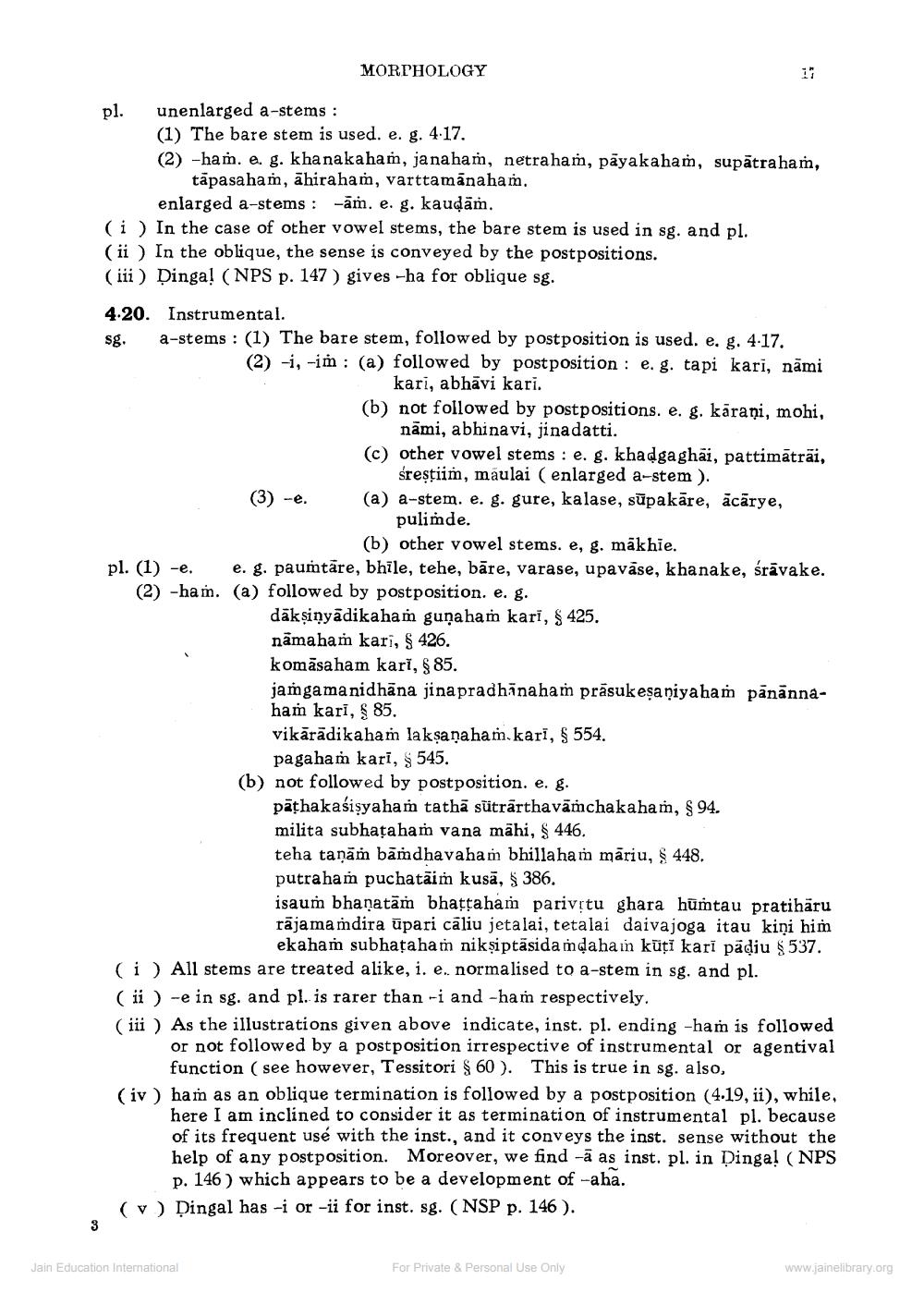________________
MORPHOLOGY
pl. unenlarged a-stems :
(1) The bare stem is used. e. g. 4.17. (2) -ham. e. g. khanakaham, ja naham, netraham, pāyakaham, supátraham,
tāpasaham, āhiraham, varttamānaham.
enlarged a-stems: -ām. e. g. kaudām. (i ) In the case of other vowel stems, the bare stem is used in sg. and pl. (ii) In the oblique, the sense is conveyed by the postpositions. (iii) Dinga! ( NPS p. 147) gives -ha for oblique sg.
4.20. Instrumental. sg. a-stems : (1) The bare stem, followed by postposition is used. e. g. 4.17. (2) -i, -im : (a) followed by postposition : e. g. tapi kari, nāmi
kari, abhāvi kari. (b) not followed by postpositions. e. g. kärani, mohi,
nāmi, abhinavi, jinadatti. other vowel stems : e. g. khadgaghäi, pattimāträi,
śreștiim, maulai (enlarged a-stem ). (3) -e. (a) a-stem. e. g. gure, kalase, sūpakāre, ācārye,
pulimde.
(b) other vowel stems. e, g. mākhie. pl. (1) -e. e. g. paumtāre, bhile, tehe, bāre, varase, upavāse, khanake, śrāvake. (2) -ham. (a) followed by postposition. e. g.
dākṣinyadikaham guna ham kari, $ 425. nāmaham kari, S 426. komāsa ham kari, & 85. jamgamanidhāna jina pradhanaham prāsukeşaniyaham panānnaham kari, $ 85. vikārādikaham laksanaham.kari, $ 554.
pagahan kari, $ 545. (b) not followed by postposition. e. g.
pathakaśişyaham tathā sütrārthavāmchakaham, S 94. milita subhațaham vana māhi, $ 446. teha taņām bāmdhavaham bhillaham māriu, S 448. putraham puchatāim kusā, $ 386. isaum bhanatām bhattaham parivítu ghara hūmtau pratihäru rājamamdira üpari cāliu jetalai, tetalai daivajoga itau kini him
ekaham subhațaham nikşiptāsida mdaha in kūti kari padiu 8537. (i ) All stems are treated alike, i. e. normalised to a-stem in sg. and pl. ( i ) -e in sg. and pl. is rarer than -i and -haṁ respectively. (iii) As the illustrations given above indicate, inst. pl. ending -ham is followed
or not followed by a postposition irrespective of instrumental or agentival
function ( see however, Tessitori $ 60 ). This is true in sg. also, (iv) ham as an oblique termination is followed by a postposition (4.19, ii), while,
here I am inclined to consider it as termination of instrumental pl. because of its frequent use with the inst., and it conveys the inst. sense without the help of any postposition. Moreover, we find -ā as inst. pl. in Dingal (NPS
p. 146 ) which appears to be a development of -aha. ( v ) Dingal has -i or-ii for inst. sg. (NSP p. 146).
Jain Education International
For Private & Personal Use Only
www.jainelibrary.org




